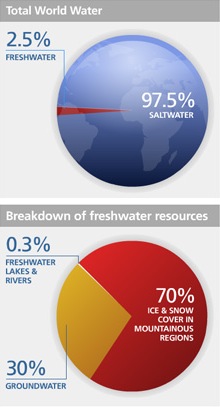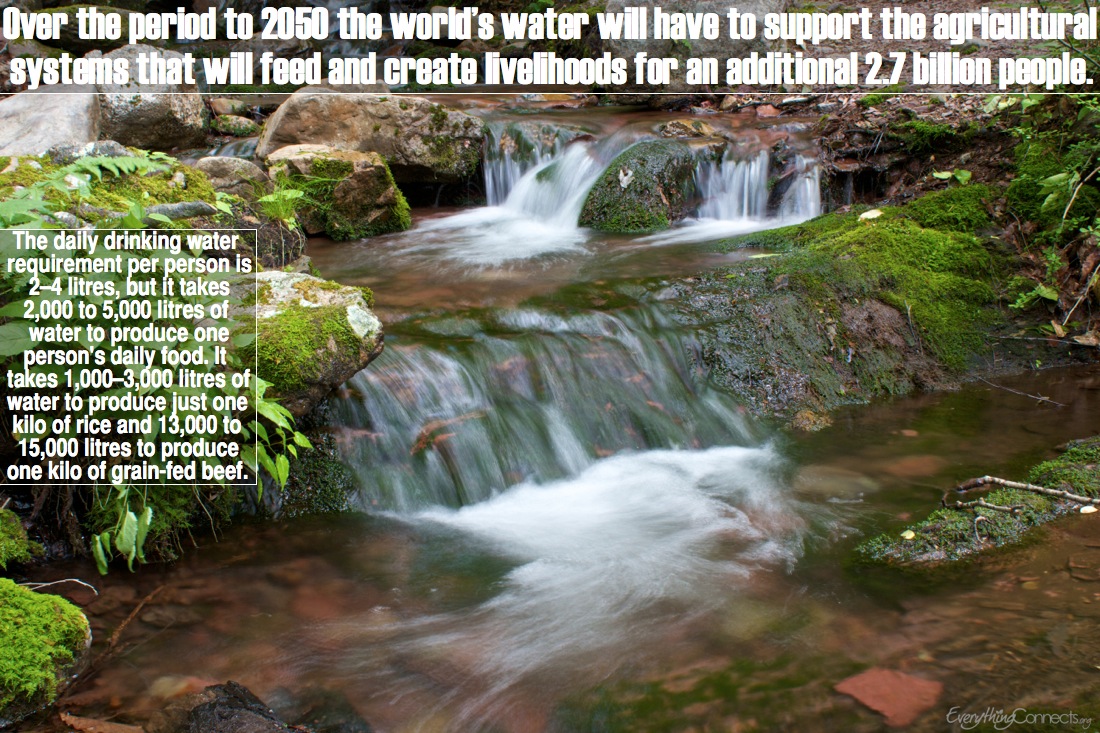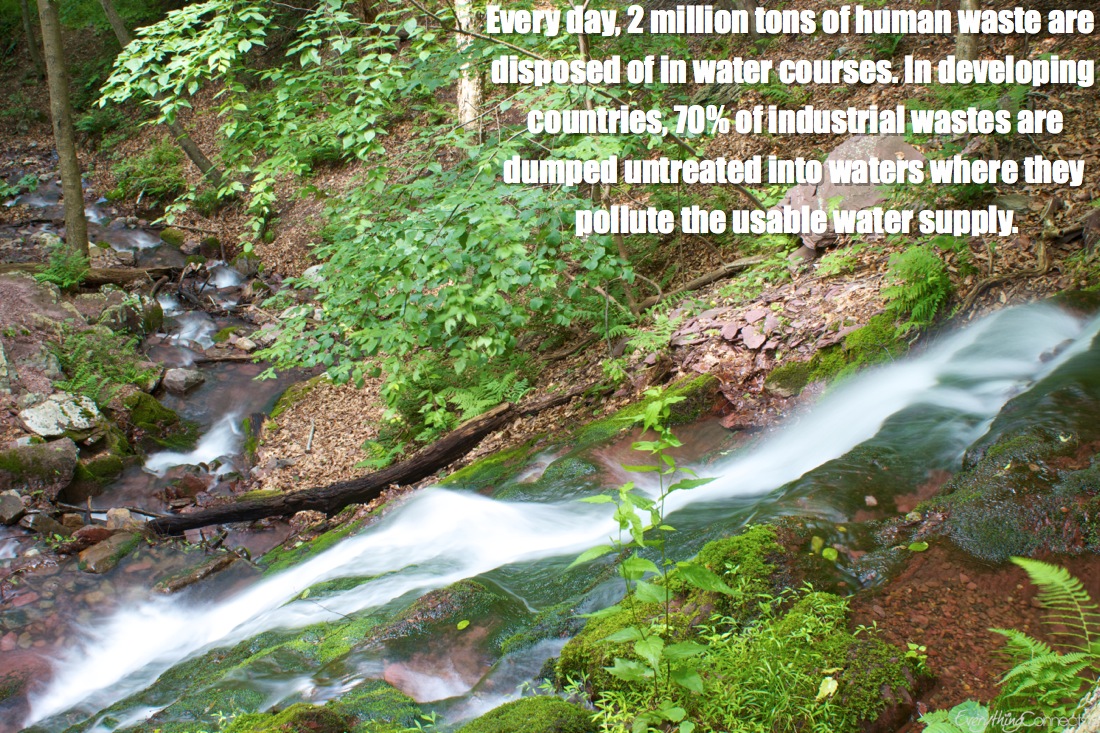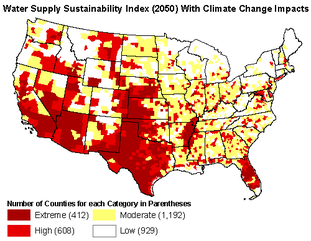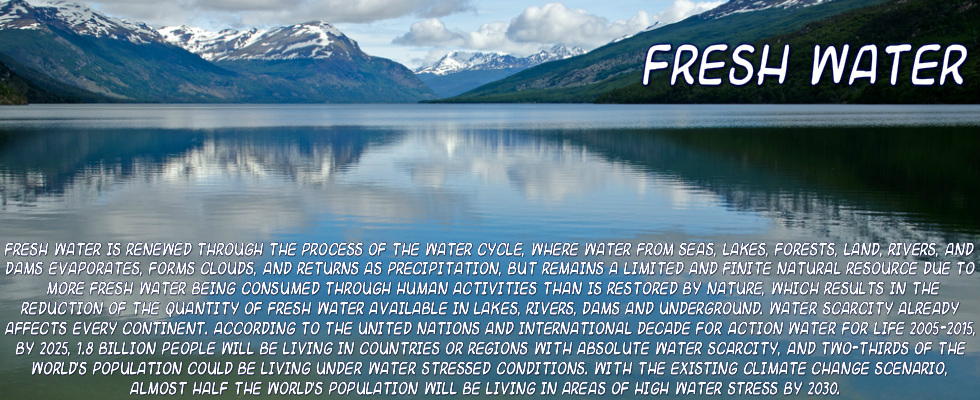
Fresh Water
According to
UN-Water, 75% of planet Earth is covered in water. 97.5% of that is ocean and 2.5% is freshwater. 70% of freshwater is divided into glaciers and ice caps and the remaining 30% into land surface water, such as rivers, lakes, ponds and groundwater. Most of the freshwater resources are either unreachable or too polluted, leaving
less that 1% of the world's freshwater,
or about
0.003% of all water on Earth, readily accessible for direct human use.
70% of this unpolluted freshwater is used for irrigation, 22% for industry and 8% for domestic use. Fresh water is renewed through the process of the
water cycle, where water from seas, lakes, forests, land, rivers, and dams evaporates, forms clouds, and returns as precipitation, but remains a
limited and finite natural resource
due to
more fresh water being consumed through human activities than is restored by nature, which results in the reduction of the quantity of fresh water available in lakes, rivers, dams and underground. Water scarcity already
affects every continent. According to the
United Nations and International Decade for Action Water for Life 2005-2015, by 2025, 1.8 billion people will be living in countries or regions with absolute water scarcity, and two-thirds of the world's population could be living under water stressed conditions. With the existing
climate change scenario, almost half the world's population will be living in areas of high water stress by 2030. The main, overlying cause of the decrease in fresh water supply is the
continuous growth of the human population, which is putting further stress on already shrinking freshwater resources. Moreover,
urbanization, higher standards of living, the
increase in per capita water use,
water pollution
and subsequent
eutrophication
also reduces the availability of fresh water
and
global warming is exacerbating and securing the global water crisis
by
increasing the intensity, frequency and duration of heat waves and droughts,
melting glaciers in the polar regions, which then mix with salt water and become too salty to drink and leads to an increase in ocean volume which causes sea levels to rise, contaminating freshwater sources along coastal regions with seawater, and
creates more intense extreme weather events, such as hurricanes and floods, which can contaminate and destroy freshwater resources. To make things worse,
energy industry water use is set to double by 2035. As
UN-Water states, "Collecting water is expected to become increasingly burdensome with global warming. More regions will experience water shortages, as rainfall becomes erratic, glaciers melt and seas rise. People living within 60 miles of a shoreline — a full third of the world's population — will be hit especially hard, as they are most susceptible to increased salinity of coastal potable water sources."
The demand for freshwater is increasing by 64 billion cubic meters a year (1 cubic meter = 1,000 liters), which has caused freshwater withdrawals to triple over the last 50 years. According to the
Global Outlook for Water Resources to the Year 2025, it is estimated that by 2025, more than half of the world population will be facing water-based vulnerability and
human demand for water will account for 70% of all available freshwater. Furthermore, a report in November 2009 by the
2030 Water Resources Group suggests that by 2030, in some developing regions in the world, water demand will exceed supply by 50% and
a report jointly produced by more than two dozen U.N. bodies states that, "By 2030, nearly half of the world's people will be living in areas of acute water shortage." The planet is in the midst of what the United Nations is calling a "Global Water Crisis." Freshwater is the most fundamental finite resource with no substitutes for most uses, yet
we are consuming fresh water at least 10 times faster than it is being replenished in regions of northern Africa, the Middle East, India, Pakistan, China, and the US.
According to the World Resources Institute, "Freshwater ecosystems – the diverse communities found in lakes, rivers, and wetlands – may be the most endangered of all. Some 34 percent of fish species, mostly from fresh water, are threatened with extinction, according to the latest tally of the World Conservation Union (IUCN), which tracks threats to the world’s biodiversity. Freshwater ecosystems have lost a greater proportion of their species and habitat than ecosystems on land or in the oceans; in addition, they are probably in greater danger of further losses from dams, pollution, overfishing, and other threats. In extent, freshwater ecosystems are quite limited, covering only about 1 percent of the Earth’s surface. Yet, they are highly diverse and contain a disproportionately large number of the world’s species." According to water scientists,
this water scarcity may force the world into vegetarianism in the not so distant future.
Discover
What
Makes
Clean,
Abundant
Water
So
Important
According to
UN-Water,
"The Intergovernmental Panel on Climate Change predicts yields from rain-dependent agriculture could be down by 50 percent by 2020. Due to climate change, Himalayan snow and ice, which provide vast amounts of water for agriculture in Asia, are expected to decline by 20 percent by 2030.
Over 1.4 billion people currently live in river basins where the use of water exceeds minimum recharge levels, leading to the desiccation of rivers and depletion of groundwater. In
60 percent of European cities with more than 100,000 people, groundwater is being used at a faster rate than it can be replenished."
Visit FAO's global information system on water and agriculture, AQUASTAT, to discover information on water resources, water uses, and agricultural water management on global, regional, and national levels:
"Rest assured,
the world’s supply of drinkable freshwater is depleting — fast," as described in the book,
Running Out of Water: The Looming Crisis and Solutions to Conserve Our Most Precious Resource.
The Great Lakes
account for over
80%
of North America’s surface freshwater and provide drinking water to
40 million
U.S. and Canadian citizens. Discover how the freshwater these lakes contain are
being threatened by climate change.
The planet is in the midst
of what the United Nations is calling a "Global Water Crisis." As the UN
states, "Around 1.2 billion people, or almost one-fifth of the world's population, live in areas of physical scarcity, and 500 million people are approaching this situation. Another 1.6 billion people, or almost one quarter of the world's population, face economic water shortage (where countries lack the necessary infrastructure to take water from rivers and aquifers)." ~
UNEP: Water - Investing in Natural Capital
| “We never know the worth of water till the well is dry.” ~ Thomas Fuller
|
According to a
study published in Nature,
"Unsustainable depletion of groundwater has recently been documented on both regional, and global scales. We estimate that the size of the global groundwater footprint is currently about 3.5 times the actual area of aquifers and that about 1.7 billion people live in areas where groundwater resources and/or groundwater-dependent ecosystems are under threat."
Global warming
will increase the risk of water shortages in one-third of counties in the continental United States by 2050. More than 400 of these counties will face extremely high risks of water shortages. Learn more.
Food shortages could force world into vegetarianism,
warn scientists: Water scarcity's effect on food production means radical steps will be needed to feed population expected to reach 9bn by 2050 - "Leading water scientists have issued one of the sternest warnings yet about global food supplies, saying that the world’s population may have to switch almost completely to a vegetarian diet over the next 40 years to avoid catastrophic shortages. Humans derive about 20% of their protein from animal-based products now, but this may need to drop to just 5% to feed the extra 2 billion people expected to be alive by 2050,
according to research
by some of the world’s leading water scientists. Competition for water between food production and other uses will intensify pressure on essential resources, the scientists said. “The UN predicts that we must increase food production by 70% by mid-century. This will place additional pressure on our already stressed water resources, at a time when we also need to allocate more water to satisfy global energy demand — which is expected to rise 60% over the coming 30 years — and to generate electricity for the 1.3 billion people currently without it,” said the report." ~
The Guardian
Water Crisis Fast Facts
780 million people, which is more than 2 1/2 times the U.S. population or approximately one in nine people, lack access to clean water. 3.4 million people, which is almost the entire city of Los Angeles, die each year from a water related disease, along with one child every 20 seconds. The water and sanitation crisis claims more lives through disease than any war claims through guns. Lack of access to clean water and sanitation kills children at a rate equivalent of a jumbo jet crashing every four hours.
According to the
Turn Down the Heat: Why a 4°C Warmer World Must be Avoided, by the
World Bank, mean-annual runoff will decrease by 20-40% in the Danube, Mississippi, Amazon and Murray Darling Basin in a 2°C world, and double in a 4°C world.
Avert Climate Change
Further Resources


